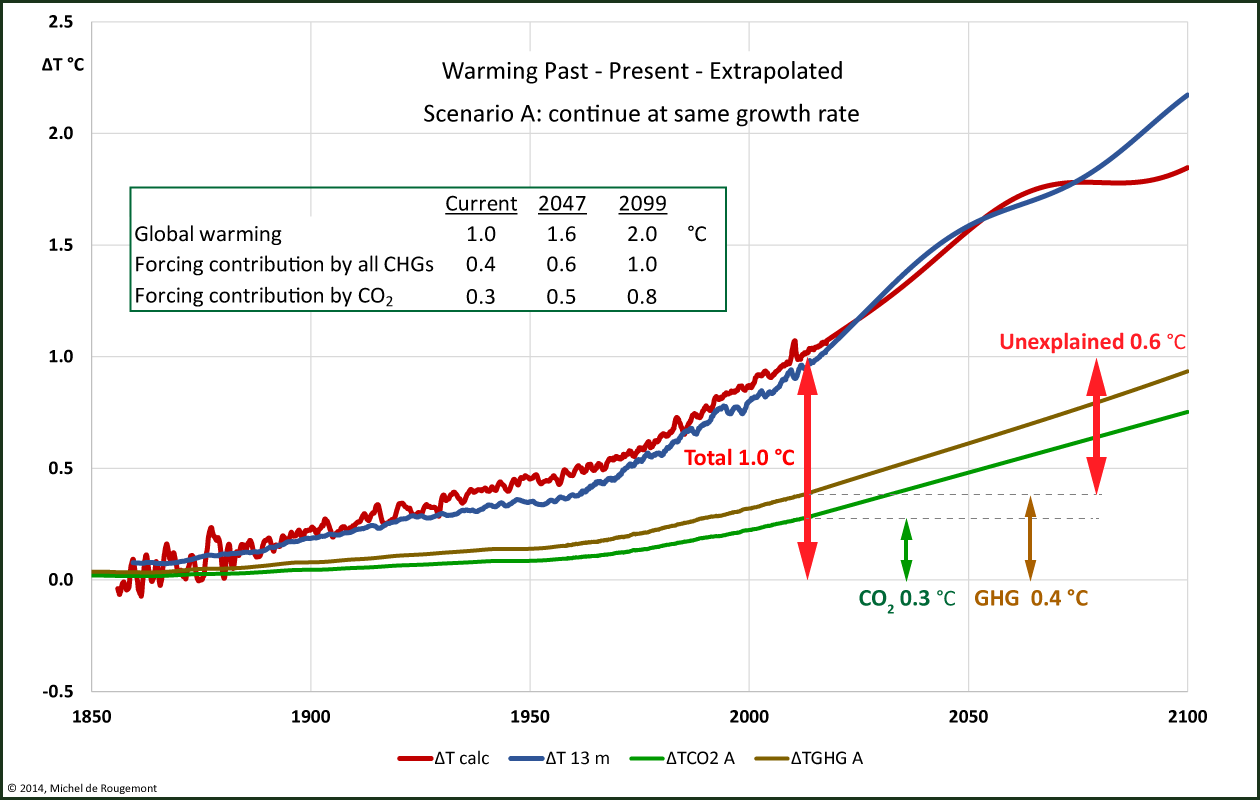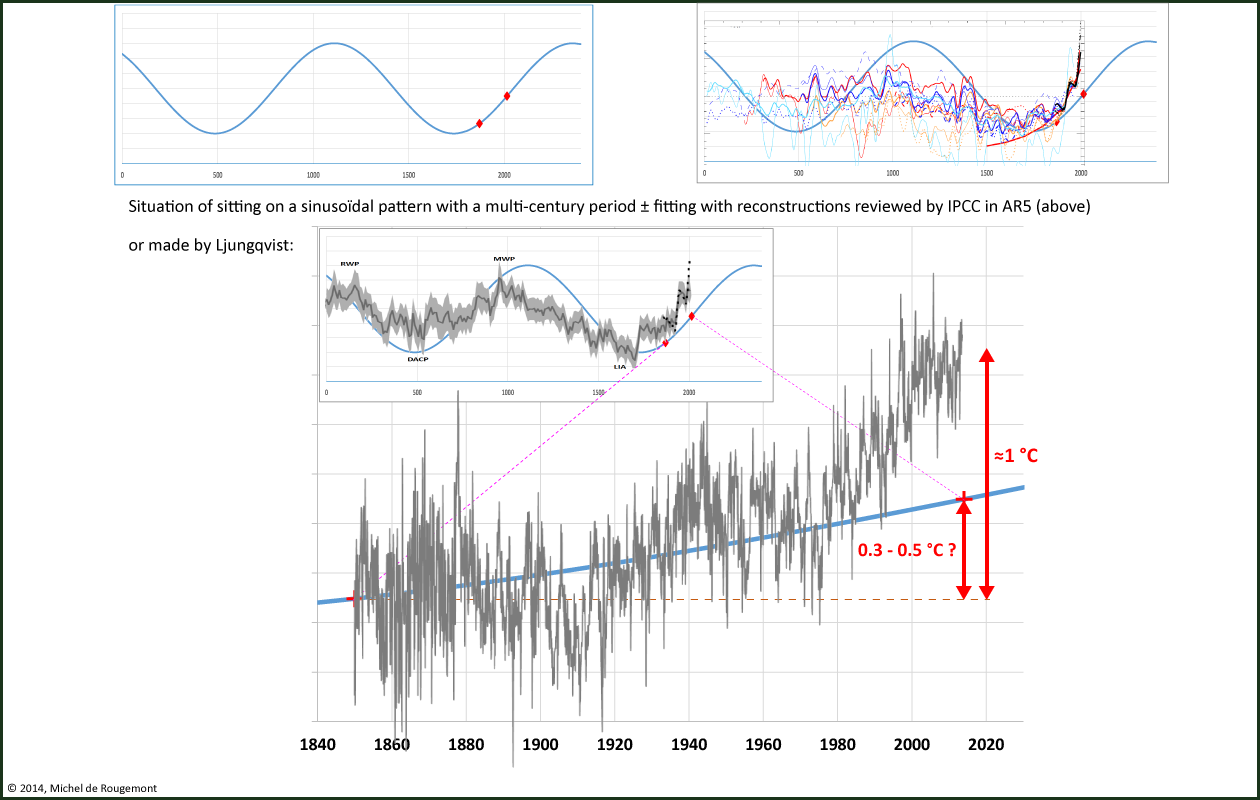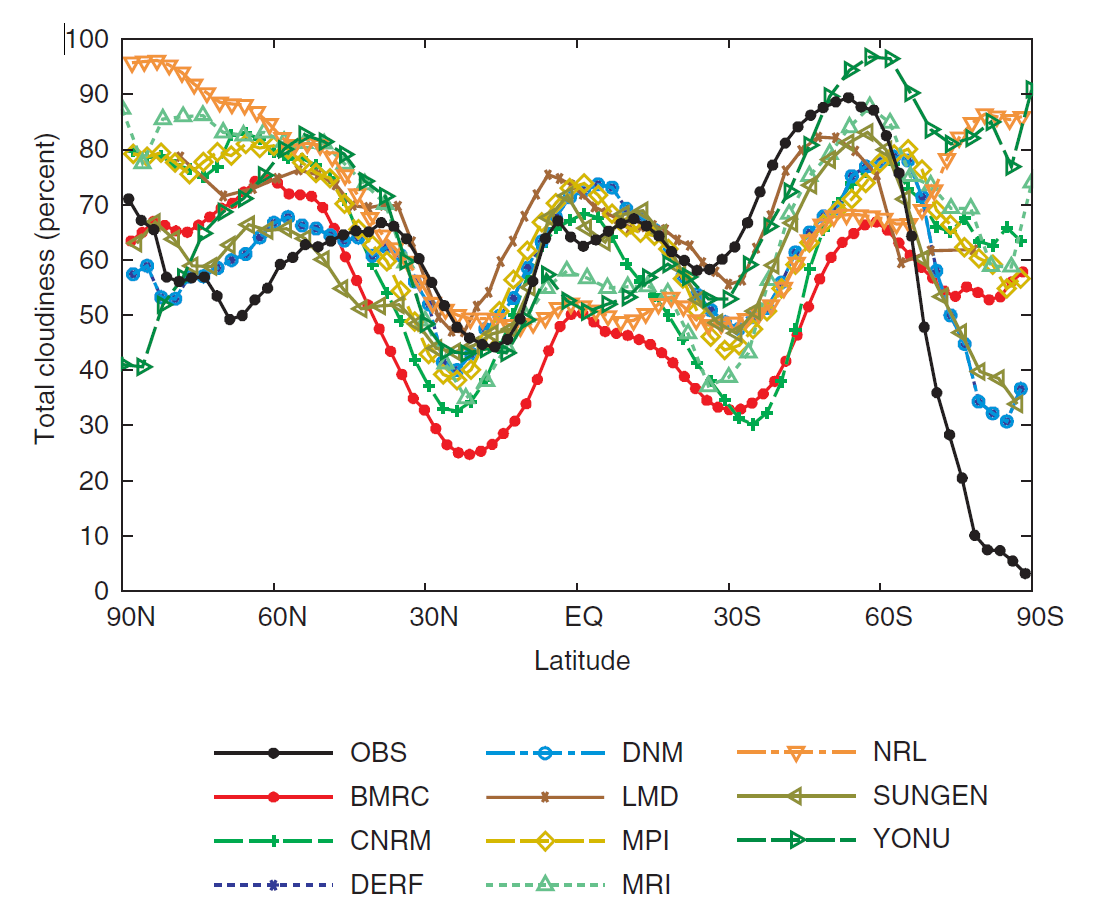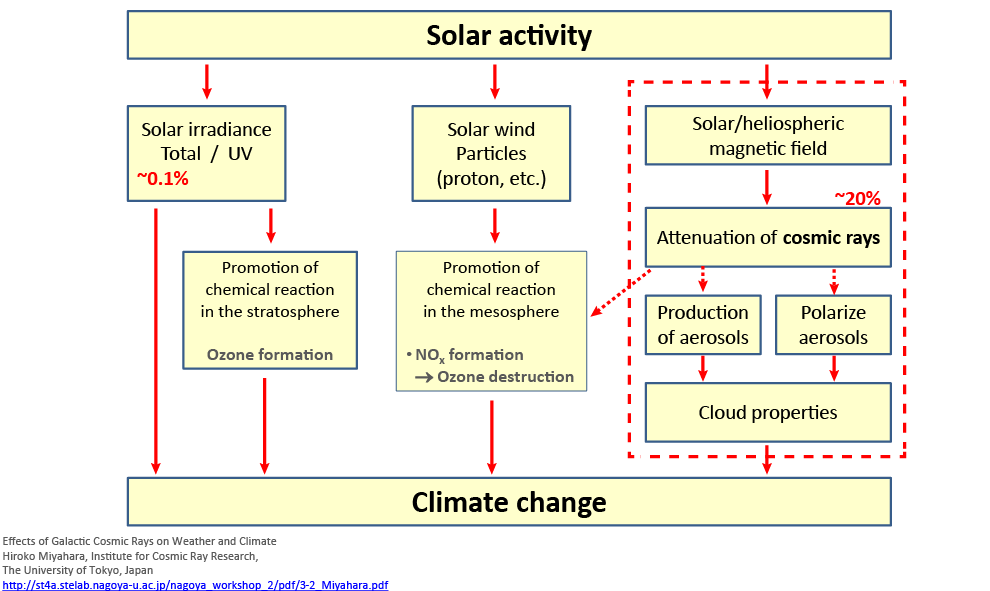Forcings due to GHGs can be calculated from their concentrations with the formula proposed by Myrhe:

Radiative forcing calculated with Myhre’s formulas based on absorption
of long wave (IR) radiation.
Extrapolation
All predictions, in particular into the future, are risky for those believing them. But let’s take some risk.
By regression analysis, formulas were obtained (link) expressing Temperature anomaly as a function of CO2 concentration (used as a proxy for natural or artificial forcing effects), Atlantic Multidecadal Oscillation, solar spots, and sea level. To apply the formula over a certain future time frame, scenarios are needed that describe the possible evolution of the underlying parameters.
Perpetuation of solar spot counts was taken from a regression formulas (see Solar spot figure), and a simple sinusoidal curve with a period of 65 years was chosen for AMO.
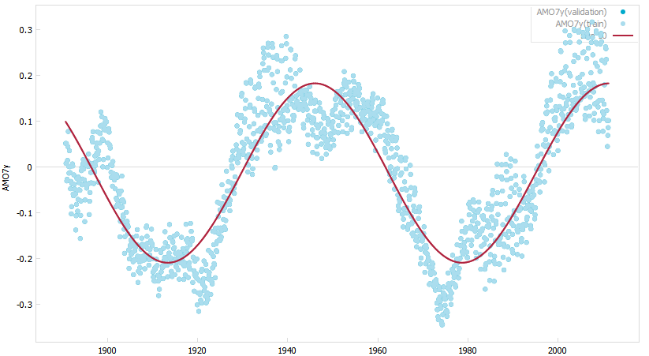
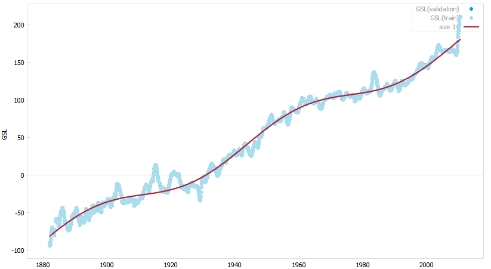
For the sea level (above on the right), a good fit (R2= 0.986) was obtained with following formula:
GSL = 2.053*Time + 15.073*sin(0.097*Time) - 3950
This formula suggests a steady rise rate of 2 mm per year with fluctuations over a 65 year period.
By the way, the period observed in fluctuations of the rate of rise of the sea level coincides with the period of AMO variations, a parameter based on water temperature at the sea surface. Thermal dilatation may play a role in this.
For CO2, the usual culprit, four scenarios were chosen, with CO2 as a proxy for all GHG-like forcings. All scenarios assume that methane and nitrous oxide will continue developing in parallel with the CO2 rise rate.
A. Do nothing scenario.
The CO2 concentration continues to grow at the same rate as over the past 10 years, this implies a compounded annual growth rate (CAGR) of 0.67%.
B. Highest carbon scenario until all fossil reserves will have been burned.
An almost unthinkable positive world development scenario.
The CO2 concentration is as assumed to increase 50% faster than in scenario A. Therefore, the CAGR is 1.0 % p.a.
C. Freeze scenario.
All emissions are maintained at the current level of 9 Pg C per year, no growth. This means that the CO2 concentration increases steadily by 2.2 ppm every year.
Savings in some countries being cancelled by expansion in others.
K. Kyoto like, lowest carbon scenario.
All emissions are reduced to 8% below the 1991 level, 5.7 Pg C per year.
This was the original aim of the Kyoto protocol. This means that the CO2 concentration would increase by 1.5 ppm every year.
The control scenarios C and K are supposed to be implemented at once, which is unrealistic (but easy to calculate).
The evolution of the CO2 concentration will look as follows:
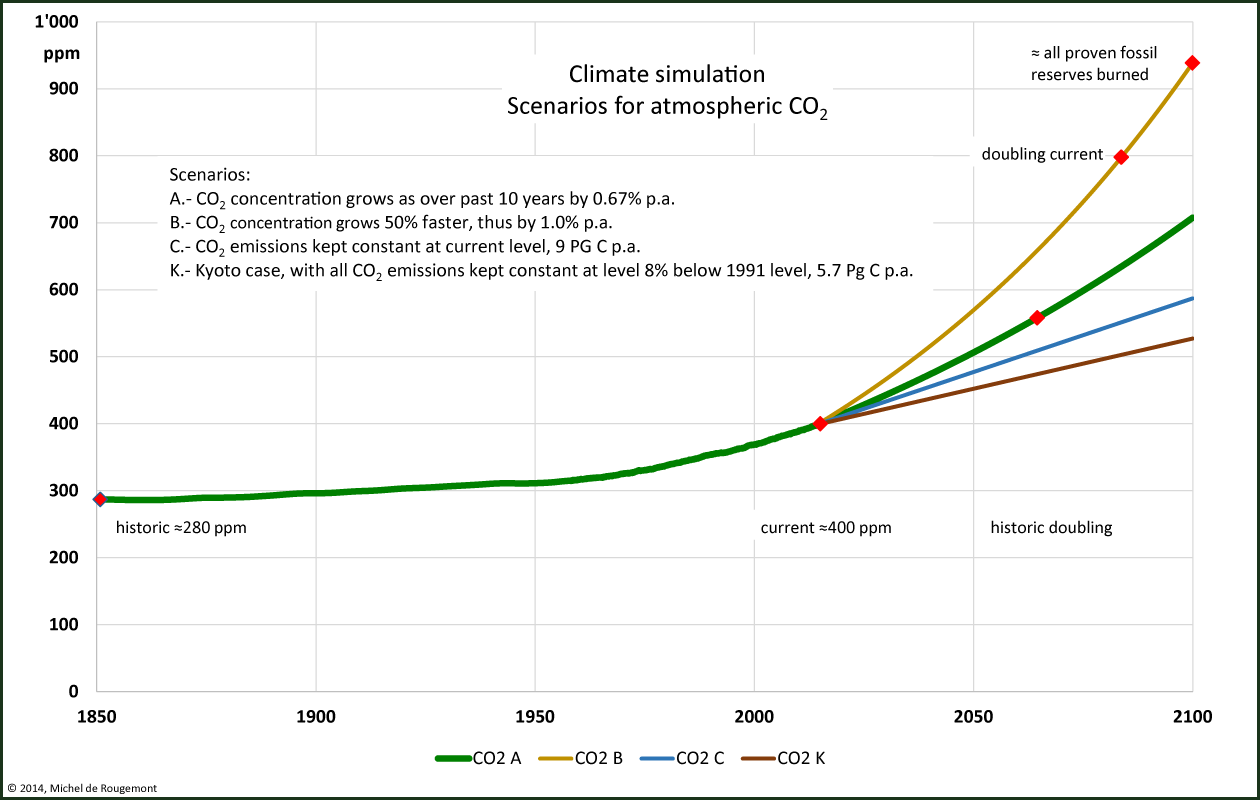
CO2 Projections of CO2 concentration according to 4 scenarios
Combining the correlation formulas and the calculation of radiative forcing by CO2 and other GHGs provides the following simulations:
This is an original view, constructed with rigor and
revealing that part of the warming cannot be attributed to CO2 and other GHGs
In this chart, the warming as observed and extrapolated is compared with the warming that can be attributed to the known greenhouse gases, taking into account the feedbacks discussed in the past chapter. The calculation for all 4 scenarios can be presented in a table form.
| As of today (2014), compared to pre-industrial era | Additional warming between today and 2047[1] | and in 2099 |
||||||
|
ΔT observed overall |
ΔT due to all GHGs |
ΔT due to CO2 only |
ΔT not explained |
ΔT extra-polated overall |
ΔT due to all GHGs |
ΔT due to CO2 only |
ΔT due |
|
|
Scenario A |
0.98 °C |
0.39 °C |
0.28 °C |
0.59 °C |
0.40 |
0.21 |
0.19 |
0.47 |
|
Scenario B |
0.59 |
0.31 |
0.28 |
0.70 |
||||
|
Scenario C |
0.37 |
0.16 |
0.14 |
0.32 |
||||
|
Scenario K |
0.20 |
0.11 |
0.10 |
0.23 |
||||
Warming observed, extrapolated from observation, and calculated from radiative forcing according to Myhre’s formulas.
Average feedback factor λ=-1.59 K W-1 m2 applied.
Potential effect of carbon dioxide emission reduction.
From the calculations presented here it is possible to show what differences could be achieved in 2047 or at the end of this century according to the chosen scenario.
Some important findings:
- Overall, the doing nothing scenario A may result in a temperature increase over the present 2014 situation of 0.4 °C in 2047 and of 1.1 °C in 2099 (1.3 °C and 2.1 °C since BIE).
With this same scenario the contribution of CO2 alone may be 0.2 °C and 0.5 °C. - The worst case highest carbon scenario for warming – but an ideally best case for economic and social development (scenario B) – may see the temperature increase by 0.6 °C in 2047 and by 1.4 °C in 2099 (1.6 °C and 2.4 °C since BIE).
In this case, the contribution of CO2 alone would be 0.3 °C and 0.7 °C. - Adopting the best Kyoto-like lowest carbon scenario (K) as compared to doing nothing (A), the warming due to CO2 would be reduced by 0.1 °C in 2047 and by 0.1 °C in 2099.
- In all cases the temperature continues to increase, although more slowly as CHG concentrations increase (logarithmic dependency).
In the above table, “ΔT not explained” is the difference between the observed warming and the one that can be attributed to GHGs only.
To produce the not explained 0.59 °C, an additional primary forcing of 2.91 W m-2 must be caused by something that has not yet been identified.
In other words, radiative forcing by GHGs cannot explain 60% of the observed warming since the BIE.
To fill the gap, one may be tempted to tune the model, and to apply a large positive feedback factor λ to the whole system, somehow to force the forcing; but this would imply λ = +2.3 K W-1 m2 with which the stability of the climate system would be critically low, which is in full contradiction with Earth’s geological history and with its resilience observed after significant disturbances such as volcanic eruptions or tropical cyclones. And – last but not least – such a high positive feedback would be in full contradiction with all of the published feedback parameters reviewed by IPCC. Therefore, causes other than radiative forcing by GHGs must be found, naturally occurring or man-made[2].
Beginning with the industrial era or continuing the exit from the little ice age, these other factors must show a steady growth pattern up to the present time. Only conjectures can be made, since no other useful observation data is available – if it would be the case, I would have incorporated it in the correlation analysis.
Man-made possible factors with steady growth pattern are:
However, in IPCC’s 5th report these effects (aside of black carbon) are deemed to be of low magnitude and rather in the cooling than in the warming direction, as summarized in the nearby figure. |
|
Naturally occurring phenomena with steady growth pattern can be:
|
|
A mix of these phenomena – and others not invented here – may well fill the 2.9 W m‑2 forcing gap.
In any case, to attribute all ills – if any – to the carbon dioxide molecule appears to be an oversimplification and a considerable exaggeration.
[1] One could be tempted to ask “why 2047 ?“, and the answer being “guess why!”
[2] Women also. The reader is gently asked to consider that in this present text the masculine may, but has not to, mean the feminine, and vice versa. Grammar has no concern for equality, however it is useful to [try to] follow its rules.
[3] Bond, T. C., et al. (2013), Bounding the role of black carbon in the climate system: A scientific assessment, J. Geophys. Res. Atmos., 118, 5380–5552, doi:10.1002/jgrd.50171.



